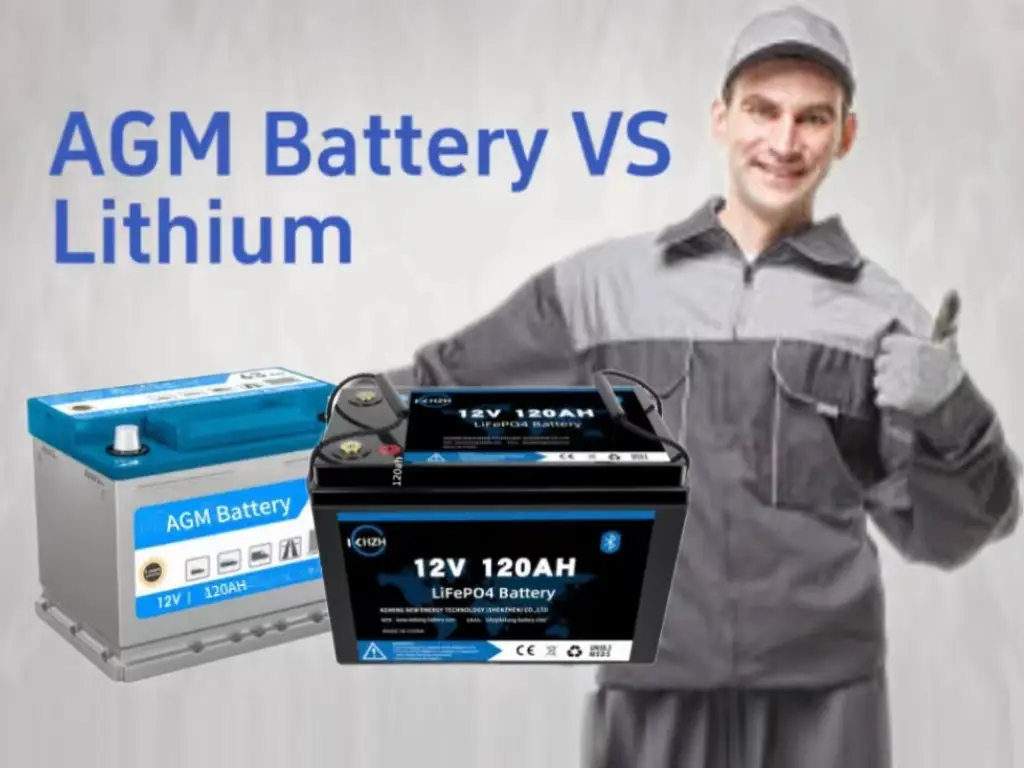In an era marked by a meteoric rise in global battery demand, anticipated to exceed 2,550 GWh by the year 2030, the deliberation between AGM (Absorbent Glass Mat) and lithium batteries has become increasingly pertinent. This decision transcends mere preference, evolving into a pivotal factor across a spectrum of applications, ranging from the propulsion of contemporary electric vehicles to the facilitation of eco-friendly home energy systems. As we embark upon a detailed examination of AGM versus lithium batteries, we intend to probe into critical facets such as energy efficiency, operational longevity, cost implications, and ecological impacts. This comparative analysis ventures beyond theoretical discourse; it represents an expedition to ascertain the battery technology that most aptly aligns with your individual requirements, whether it’s powering a journey in an RV or fortifying a sustainable energy solution for residential use. We invite you to join us in dissecting the intricacies of these two formidable power sources.

What is an AGM Battery?
AGM (Absorbent Glass Mat) batteries represent a specialized category within the lead acid battery family, distinguished by their unique construction where the electrolyte is intricately absorbed into a fine fiberglass mat. These batteries, a stalwart in the energy storage landscape since the 1980s, are renowned for their robust durability and steadfast reliability. Engineered with a spill-proof design, courtesy of the absorbent glass mat, they exhibit remarkable resilience. This makes them exceptionally suited to withstand the rigors of mobile environments such as recreational vehicles (RVs) and marine applications, adeptly handling vibrations and jolts that would challenge conventional lead acid batteries. However, in a parallel to the venerable yet hefty old trucks, AGM batteries are somewhat weightier and lack the higher energy density found in more contemporary counterparts, particularly lithium batteries, which have risen to prominence in recent years.
What is a Lithium Battery?
Lithium batteries, especially those of the Lithium Iron Phosphate (LiFePO4) variety, epitomize the pinnacle of battery technology, akin to sleek sports cars in their domain. These batteries are characterized by their reduced weight, augmented energy density, and extended lifespan, significantly outshining traditional Absorbed Glass Mat (AGM) batteries in these aspects.
Resembling the advanced functionality of smartphones, LiFePO4 batteries are integrated with sophisticated Battery Management Systems (BMS). This advanced feature endows them with the capability to intelligently avert issues such as overcharging and deep discharging. As a result, their cycle life far surpasses that of AGM batteries. Additionally, their superior efficiency in terms of energy storage and delivery renders them highly advantageous in applications with elevated energy demands, notably in electric vehicles and renewable energy systems.
You May Like: How Are Lithium Batteries Made? A Comprehensive Guide
Comparing Energy Efficiency
Absorbed Glass Mat (AGM) batteries, long-established as a mainstay in this sector, demonstrate an admirable energy efficiency, typically in the range of 80-85%. This efficiency ratio implies that for every 100 watts of energy input, an AGM battery proficiently yields approximately 80-85 watts of output, underscoring its proficient energy utilization capabilities.
Conversely, lithium-ion batteries, frequently heralded as the epitome of energy efficiency within the battery sphere, exhibit an exceptional efficiency spectrum of roughly 95-98%. This elevated efficiency rate is indicative of minimal energy loss, thereby ensuring optimal energy preservation during both charging and discharging processes. Consequently, lithium-ion batteries are consistently the best choice in scenarios where superior energy efficiency is paramount. Such scenarios predominantly encompass applications like solar energy storage systems and electric vehicles, where the efficiency of energy conversion and optimal utilization is crucial for attaining operational efficacy and advancing environmental sustainability.
Lifespan and Durability Analysis
Absorbed Glass Mat (AGM) batteries, notable for their resilience, typically provide a service life of 4 to 7 years, accommodating 300 to 1200 charge cycles, contingent upon usage intensity. These batteries exemplify consistent performance over extended periods, although they exhibit a gradual capacity diminution over time. In stark contrast, lithium batteries offer a longer lifespan, generally spanning 10 to 15 years, with the capacity to withstand 1000 to 5000 charge cycles. This impressive longevity not only mirrors their intrinsic robustness but also highlights the advanced engineering and technological sophistication inherent in their design. Regarding durability, AGM batteries demonstrate commendable robustness, particularly in adverse operational environments. Lithium batteries, however, surpass in this criterion, displaying a remarkable tolerance to deep discharge cycles while minimally affecting their overall lifespan. This attribute of superior durability, even under rigorous conditions, positions lithium batteries as the preferable option in applications where both longevity and resilience are paramount.
Charge and Discharge Rates Compared
AGM (Absorbent Glass Mat) batteries, exhibit moderate charging rates, necessitating approximately 5-8 hours for a full charge. This duration hinges on the battery’s capacity and the charger’s output. Their discharge rates, characterized by a gradual decrease, can be suboptimal in scenarios demanding rapid power delivery, such as in motorhomes or off-grid applications.
Lithium batteries, particularly Lithium Iron Phosphate (LFP) types, markedly excel with their expeditious charging capabilities, achieving a full charge within 1-3 hours. This rapid charging is coupled with efficient discharge rates, entailing fewer electrical losses and a more consistent delivery of power. Their efficiency and the ability to handle a deeper depth of discharge (DoD) make them suitable for high-demand scenarios like electric vehicles, where swift power bursts are crucial, or in solar energy storage systems, where they adeptly manage fluctuating solar inputs.
This notable variance in energy absorption and release rates delineates the distinct applicability of AGM and lithium batteries. AGM batteries, forming a reliable battery bank, may be preferred for their longer operating time and warranty assurances in settings where energy demands are steady but less intense. Conversely, the efficiency and robust cycling capabilities of lithium batteries make them a no-brainer for dynamic and high-demand environments. Their proximity to new battery technology standards and accessories further bolsters their suitability across diverse applications.
Size and Weight Considerations
Absorbed Glass Mat (AGM) batteries, renowned for their high energy density, typically exhibit a substantial heft, with a standard 100 Ah AGM battery tipping the scales at an approximate 60-70 pounds and manifesting in more voluminous dimensions. This pronounced bulkiness often emerges as a notable downside in scenarios where spatial limitations are paramount or where the facilitation of mobility is critical.
In contrast, lithium iron phosphate batteries present a markedly more compact and lightweight alternative. For an illustrative comparison, a lithium battery boasting an equivalent capacity of 100 Ah registers a significantly reduced weight, approximately 30-40 pounds, effectively halving the mass of its AGM counterpart. Additionally, these batteries typically possess a more diminutive form factor and need less space, rendering them supremely suited for applications where the optimization of space and minimization of weight are crucial, such as in recreational vehicles, marine vessels, and portable solar power systems. This substantial weight savings and reduction in spatial requirements, achieved without sacrificing power output, firmly establishes lithium iron phosphate batteries as the best option in scenarios that prioritize high energy efficiency and enhanced portability.
Also Read: Master Group 24 Battery Dimensions, Features & Tips with This Guide
Cost Analysis: AGM vs Lithium
In the fiscal assessment of battery options, AGM (Absorbent Glass Mat) batteries often present lower upfront costs compared to lithium-ion counterparts. This cost advantage positions AGM batteries as a budget-conscious choice. However, an informed decision must account for long-term expenditures. Agm batteries require more maintenance and frequent replacement which can add up to the cost in the long run. Lithium-ion batteries, including lithium iron phosphate variants, though bearing a higher price, frequently emerge as the more economical option over time. Their extended battery life, coupled with a greater depth of discharge, low maintenance and efficiency, offsets the initial outlay. Particularly in applications with intensive battery utilization, the longevity and less space attributes of lithium-ion batteries render them the better option, ensuring both financial prudence and operational efficiency.
Environmental Impact and Sustainability
In the realm of environmental sustainability, lithium-based energy storage solutions demonstrate a commendable reduction in ecological footprint, particularly when juxtaposed with Absorbent Glass Mat (AGM) batteries. AGM batteries, a subset of the lead acid battery family, incorporate elements like lead and sulfuric acid, necessitating rigorous recycling protocols to alleviate environmental degradation. The production and disposal of these batteries demand meticulous management, attributed to the presence of these deleterious materials.
Conversely, lithium batteries are frequently lauded for their more environmentally benign profile. Notably devoid of heavy metals such as lead, they substantially diminish the likelihood of soil and water contamination. While the fabrication of lithium batteries is not devoid of environmental concerns, particularly regarding the extraction of raw materials, their cumulative lifecycle impact is generally inferior to that of AGM batteries. This factor, in conjunction with their extended durability and superior efficiency, frequently renders lithium batteries a more sustainable alternative in scenarios where environmental considerations are paramount.
Safety Features and Risks
Safety first, right? AGM batteries are pretty stable and safe. They’re like the dependable older sibling. Their sealed design reduces the risk of battery acid spills or gas emissions under normal operating conditions. Lithium batteries, while generally safe, do require more sophisticated management systems to monitor temperature and voltage. This is because they’re more sensitive to issues like overcharging or deep discharging. But with a good BMS, lithium batteries are as safe as houses.
Which One is Better?
Determining the superior battery choice necessitates a bespoke approach, meticulously aligning the battery’s capabilities with your distinct requirements. This decision transcends the simplistic one-size-fits-all methodology, venturing into the realm of tailored solutions for individual scenarios. Whether the application encompasses marine adventures, vehicular journeys in an RV, the intricacies of solar power harnessing, or the leisure of a golf course, the optimal battery selection is markedly divergent. The following table succinctly outlines their key differences and attributes, providing a clear basis for our further discussion on selecting the ideal battery for various applications like marine use, RV travel, solar power systems, or golf carts:
| Criteria | AGM Battery | Lithium Battery |
| Cost | Lower initial cost, cost-effective for less intensive use | Higher initial cost, but more cost-effective in the long term due to longevity |
| Performance | Good performance, suitable for general use | Superior performance, ideal for high-demand applications |
| Lifespan | Shorter, typically 4-7 years | Longer, often 10-15 years, with some extending up to 20 years |
| Efficiency | Moderate, around 80-85% | High, approximately 95-98%, leading to less energy loss |
| Charge/Discharge Rate | Slower, taking more time to fully charge and discharge | Faster, beneficial for applications requiring quick energy turnover |
| Size and Weight | Heavier and bulkier, which might be a constraint in space-limited applications | Lighter and more compact, advantageous for portable and space-sensitive applications |
| Environmental Impact | Contains lead and sulfuric acid, requires careful disposal | Generally more eco-friendly, but manufacturing and lithium extraction have environmental considerations |
Marine Batteries

For aficionados who spend substantial durations over water, a marine battery demands more than mere energy provision. It necessitates exemplary water-resilient characteristics, prolonged operational longevity, and accelerated recharging faculties. Herein, lithium batteries excel, proffering augmented operational durations and expedited charging capabilities – quintessential for the ardent mariner and angler. Conversely, for those prioritizing fiscal prudence with moderate usage, AGM batteries emerge as a pragmatic choice, striking a harmonious balance between efficiency and economic viability.
RV Batteries
For RV enthusiasts, where the odyssey is equally pivotal as the destination, battery performance must exhibit unwavering consistency. In this sphere, the selection oscillates between lithium and AGM batteries, each presenting distinct advantages. Lithium variants, renowned for their extended lifespans and reduced mass, are tailor-made for prolonged, recurrent voyages. AGM batteries, alternatively, may be more apt for shorter, sporadic journeys, owing to their cost-efficiency and steadfast reliability.
Solar Storage Systems

Within the domain of solar energy storage, the battery choice critically impacts system efficiency and longevity. Lithium batteries, lauded for their superior energy density and minimal maintenance requisites, are superbly suited for solar configurations. Their proficiency in managing deep discharge cycles renders them ideal for enduring energy storage solutions. AGM batteries, while also feasible, are more appropriate for smaller-scale or auxiliary solar systems, particularly when budgetary limitations are predominant.
Golf Carts and Other Applications
Diverse applications, extending from golf carts to portable power systems, present unique energy demands. In contexts like golf carts, where recurrent activation and consistent power delivery are paramount, lithium batteries are often favored for their rapid rechargeability and robust endurance. In contrast, for applications with lesser energy demands, AGM batteries offer a reliable and economically sound alternative.
Final Thought
The paramount selection of an appropriate battery is intimately tied to a meticulous understanding of your distinct requirements and the intended application. This discernment process entails a deliberate balancing act, meticulously weighing factors such as cost efficiency, performance capabilities, and suitability for the specific use case. On one hand, the enhanced operational efficacy and prolonged service life inherent in lithium batteries present a compelling option, while on the other hand, the unwavering dependability and cost-effectiveness of Absorbed Glass Mat (AGM) batteries offer substantial merits. Your decision should emanate from an exhaustive and informed analysis of your unique needs, ensuring that the battery you select is not merely adequate, but exemplifies the quintessence of fit-for-purpose solution in your individual context.
Discover Keheng’s Lithium Battery Solutions
Should your preference gravitate towards lithium-based solutions, consider delving into Keheng’s array of Lithium Iron Phosphate (LiFePO4) batteries. These batteries are meticulously engineered, incorporating cutting-edge technology to provide unparalleled efficiency, extended longevity, and unwavering reliability for diverse energy requirements. Be it powering your recreational vehicle, augmenting a renewable energy system, or catering to various other applications, Keheng’s portfolio stands ready to meet your needs. We invite you to peruse our range of products and discover how Keheng can enhance the efficiency of your energy landscape.





2 thoughts on “AGM Battery vs Lithium Showdown: Which Powers Your Needs Best?”
Thanks for the valuable information. I have used it.
I confirm. I agree with told all above. We can communicate on this theme. Here or in PM.